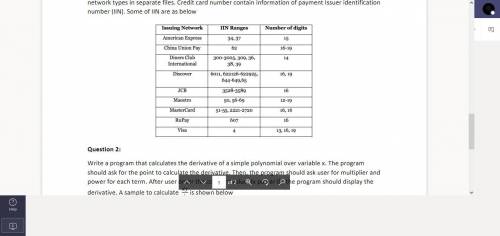
Computers and Technology, 21.07.2020 23:01 lks715
Write a program that reads card numbers from a file and separate them according to their issuing network types in separate files. Credit card number contain information of payment Issuer identification number (IIN). Some of IIN are as below


Answers: 2


Another question on Computers and Technology

Computers and Technology, 21.06.2019 17:10
3. consider the following class definitions: class smart class supersmart: public smart { { public: public: void print() const; void print() const; void set(int, int); void set(int, int, int); int sum(); int manipulate(); smart(); supersmart(); smart(int, int); supersmart(int, int, int); private: private: int x; int z; int y; int secret(); }; }; . which private members, if any, of smart are public members of supersmart? a. which members, functions, and/or data of the class smart are directly accessible in class supersmart?
Answers: 2

Computers and Technology, 22.06.2019 18:00
What is the first view you place in your drawing?
Answers: 1

Computers and Technology, 22.06.2019 20:50
What is the difference between windows 7 and windows 10?
Answers: 1

Computers and Technology, 23.06.2019 17:30
When making changes to optimize part of a processor, it is often the case that speeding up one type of instruction comes at the cost of slowing down something else. for example, if we put in a complicated fast floating-point unit, that takes space, and something might have to be moved farther away from the middle to accommodate it, adding an extra cycle in delay to reach that unit. the basic amdahl's law equation does not take into account this trade-off. a. if the new fast floating-point unit speeds up floating-point operations by, on average, 2ă—, and floating-point operations take 20% of the original program's execution time, what is the overall speedup (ignoring the penalty to any other instructions)? b. now assume that speeding up the floating-point unit slowed down data cache accesses, resulting in a 1.5ă— slowdown (or 2/3 speedup). data cache accesses consume 10% of the execution time. what is the overall speedup now? c. after implementing the new floating-point operations, what percentage of execution time is spent on floating-point operations? what percentage is spent on data cache accesses?
Answers: 2
You know the right answer?
Write a program that reads card numbers from a file and separate them according to their issuing net...
Questions



Mathematics, 28.04.2021 01:00


History, 28.04.2021 01:00


Mathematics, 28.04.2021 01:00


Mathematics, 28.04.2021 01:00







Social Studies, 28.04.2021 01:00

Mathematics, 28.04.2021 01:00



English, 28.04.2021 01:00



